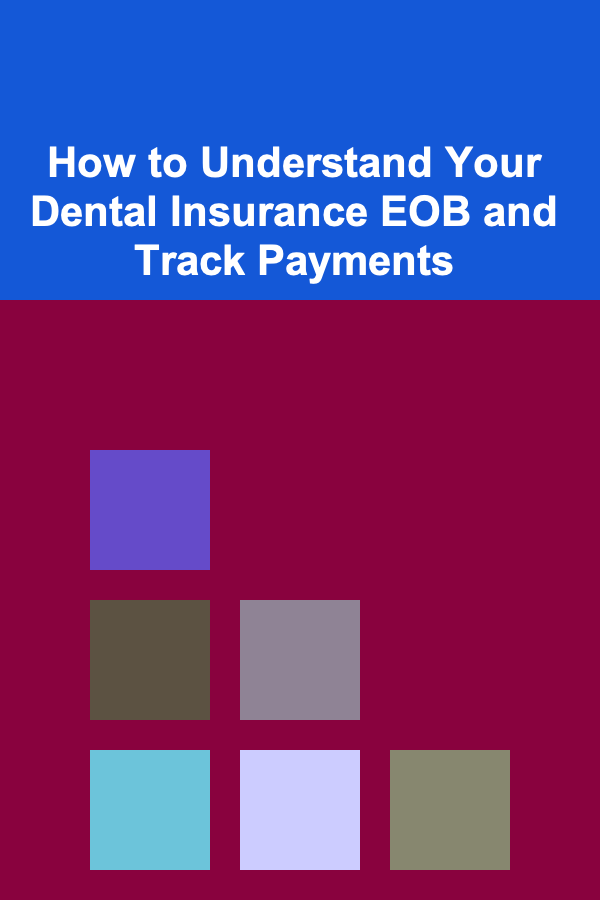
How to Understand Your Dental Insurance EOB and Track Payments
ebook include PDF & Audio bundle (Micro Guide)
$12.99$9.99
Limited Time Offer! Order within the next:

Navigating the world of dental insurance can be a complicated and sometimes overwhelming experience, especially when it comes to understanding the documents you receive after a visit to the dentist. One of the most important documents to comprehend is the Explanation of Benefits (EOB). The EOB provides crucial details regarding your dental visit, the treatment provided, how much your insurance will cover, and how much you owe out-of-pocket. Understanding the EOB and how to track payments associated with it is essential for ensuring that you're not overpaying or underutilizing your insurance benefits.
In this article, we will explore how to understand your dental insurance EOB, break down its key components, and discuss the process of tracking payments so that you can make the most of your insurance benefits. Whether you're a seasoned dental insurance holder or a first-time user, this guide will help you navigate your EOB and payments with confidence.
What Is an Explanation of Benefits (EOB)?
An Explanation of Benefits (EOB) is a document that your dental insurance provider sends you after you've received dental care. It outlines the services provided, the cost of the treatment, what your insurance plan covers, and what portion of the cost you are responsible for paying. Importantly, the EOB is not a bill; it's simply a summary of your insurance claim and provides the necessary details to understand how the costs are allocated.
While the EOB can seem complex at first glance, it's a vital tool for understanding the financial aspects of your dental treatment. The document typically comes in paper form, but many dental insurance providers also offer online access to these forms for easy tracking and management.
Key Components of an EOB
Dental insurance EOBs can vary slightly depending on your insurance provider and plan, but most will include the following key components:
1. Patient Information
The top section of your EOB typically includes patient details, such as your name, the date of service, and any relevant identification numbers. If your dental insurance plan covers dependents (such as children), their names and associated treatment details may also appear here.
2. Provider Information
This section will list the dentist or dental provider who performed the treatment, including their name and contact details. It helps you identify which provider's claim is being processed and ensures that the treatment was provided by an authorized professional under your insurance plan.
3. Service Information
Here, you'll find a breakdown of the specific dental services you received during your visit. Services are typically listed with corresponding codes (often referred to as CDT codes), which are standard codes used in the dental industry to identify specific procedures. These codes are important for insurance purposes as they help your insurance company understand exactly what services you received.
The service information will include:
- A description of the procedure (e.g., cleaning, filling, X-rays).
- The cost of each service.
- The date on which the service was provided.
4. Allowed Amount
The allowed amount refers to the maximum amount your dental insurance plan is willing to pay for a specific service. This amount may differ from the actual cost of the treatment, depending on your plan's coverage and whether the dentist is in-network or out-of-network.
If the cost of the dental service exceeds the allowed amount, you may be responsible for covering the difference (often referred to as the "balance bill"). It's important to know that your insurance provider has set these limits based on their agreements with dental providers.
5. Insurance Payment
This section will show how much your insurance has paid toward the service. It may also indicate whether the service is covered under your plan and how much of the total cost was reimbursed by the insurer. The payment amount could be adjusted depending on whether you used an in-network or out-of-network provider.
6. Patient Responsibility
The "patient responsibility" section is perhaps the most important part of your EOB, as it shows how much you owe for the service. This amount will include:
- Your deductible: If your plan has a deductible (the amount you must pay before insurance kicks in), it will be outlined here.
- Co-payment or coinsurance: These are the amounts you're required to pay for specific treatments or procedures, often expressed as a percentage.
- Non-covered services: If there were any services not covered by your plan, they'll be listed here, and you'll be responsible for the full cost.
- Balance billing: If you went to an out-of-network provider, this section will include the additional costs you must pay beyond what the insurance has covered.
7. Adjustments
This section may show any adjustments made by the insurance company, often due to negotiated discounts, errors, or corrections. If there are discrepancies or adjustments, this is where they would be reflected. It's essential to carefully review this section to ensure there are no mistakes.
8. Explanation of Denials or Limitations
If certain services were denied or have limitations based on your plan, these details will be included in the EOB. For example, if a treatment is excluded from coverage or if your insurance plan only covers a portion of a specific treatment (e.g., one cleaning per year), you will be informed here.
How to Read Your EOB: A Step-by-Step Guide
To fully understand your dental EOB and what you owe, it's essential to follow a methodical approach to reading the document. Below is a step-by-step guide to help you interpret the key components of your EOB.
1. Verify Patient and Provider Information
Ensure that all the patient details, such as your name and the date of service, are correct. Similarly, check the provider information to ensure the dentist or specialist listed is the correct provider for your treatment.
2. Review the Services
Look through the list of dental services provided. Cross-check the descriptions and codes with the treatments you received during your visit. If there are discrepancies, contact your dental office or insurance provider for clarification.
3. Understand the Allowed Amount
Identify the allowed amount for each service. This is the maximum your insurance is willing to cover. If the amount billed by the dentist exceeds this allowed amount, you will be required to pay the difference. For example, if a service costs $200 but the allowed amount is $150, you'll be responsible for the $50 difference.
4. Look for Insurance Payments
Next, verify the amount your insurance provider has paid. This will be the portion of the bill covered by your plan. Ensure that this payment aligns with your understanding of your coverage. If you're unsure whether the payment amount is correct, you can contact your insurance provider for clarification.
5. Calculate Your Responsibility
The patient responsibility section is the most critical area to focus on, as it will tell you how much you owe for the services received. This will include any deductibles, co-pays, coinsurance, and any amount not covered by insurance. If you have multiple services listed, sum the amounts to determine your total responsibility.
6. Check for Denied or Adjusted Services
If any services were denied or adjusted, pay close attention to the reason. Sometimes, services may be denied because they don't meet the criteria set by your insurance provider or because they were incorrectly billed. Understanding these reasons can help you dispute or challenge any charges.
7. Verify Your Total Payment Amount
Ensure the total payment amount you owe matches what is outlined in the EOB. This is the amount that should be paid to your dentist, either immediately or through a payment plan.
How to Track Your Payments
Once you've reviewed your EOB and understood the breakdown of costs, the next step is to track your payments and ensure that all charges are paid correctly and on time.
1. Create a Payment Log
Maintaining a log of your dental payments is essential to tracking how much you've paid and what remains due. You can use a simple spreadsheet or a budgeting app to log the date, amount paid, and any outstanding balance. This will help you stay organized and ensure that you don't miss any payments.
2. Pay the Amount Due
If the EOB indicates that you owe a balance, make arrangements to pay the amount due. Some dental offices allow you to make payments in installments, while others may require full payment upfront. If you're paying in installments, be sure to keep track of each payment.
3. Track Your Claims and Payments
If you're uncertain about whether your insurance has processed your payment correctly, use your insurance provider's online portal (if available) to check the status of your claim. Most insurance companies offer a portal where you can view the status of your claims, see any payments made, and even see when the next payment is due.
4. Ensure Your Insurance Payment Was Applied
After receiving your EOB, you should confirm that your insurance payment has been correctly applied to your balance. If there is any discrepancy, contact your insurance provider or dentist's office for clarification. In some cases, payments may take time to reflect in the dentist's billing system.
5. Appeal or Dispute If Necessary
If there's a mistake or discrepancy with your EOB, you have the right to appeal or dispute the charges. Contact your insurance provider to clarify any issues and request a review of the charges. Additionally, if your dental provider's office has made an error in billing, they can usually help resolve the issue.
Conclusion
Understanding your dental insurance Explanation of Benefits (EOB) is essential for staying on top of your dental costs and avoiding unexpected bills. By breaking down the key components of the EOB, you can ensure that you are being charged correctly and that you are making the most of your insurance benefits. Tracking payments, reviewing your claims, and addressing any discrepancies promptly will help you manage your dental expenses effectively.
While dental insurance may seem complicated at first, with the right approach and knowledge, you can feel confident navigating your EOB and keeping your dental care costs under control.
Reading More From Our Other Websites
- [Organization Tip 101] How to Store Kitchen Gadgets in a Small Drawer
- [Home Cleaning 101] How to Clean Your Mattress and Remove Dust Mites
- [Home Holiday Decoration 101] How to Add Holiday Charm to Your Front Yard
- [Organization Tip 101] How to Highlight Special Occasions with Thoughtful Jewelry Choices
- [Home Lighting 101] How to Decode Lumens vs. Watts and Choose the Perfect Brightness for Your Home
- [Personal Finance Management 101] How to Refinance a Home Loan Wisely: When It Makes Sense and When It Doesn't
- [Home Security 101] How to Use Home Security Lighting to Create a Safer Environment at Night
- [Home Pet Care 101] How to Travel with Your Pet on a Plane
- [Soap Making Tip 101] Troubleshooting Common Soap-Making Mistakes and How to Fix Them
- [Home Cleaning 101] How to Clean Your Washing Machine and Dryer

How to Declutter Your Home Office for Better Focus
Read More
How to Make Money by Raising Pigs: Turning Your Farm into a Business
Read More
How to Plan a Sustainable and Eco-Friendly Home Celebration
Read More
How to Secure Your Mailbox to Prevent Identity Theft
Read More
How to Sell Digital Products Successfully for Fitness Enthusiasts: A Comprehensive Guide
Read More
How to Store Holiday Decorations Without the Mess
Read MoreOther Products

How to Declutter Your Home Office for Better Focus
Read More
How to Make Money by Raising Pigs: Turning Your Farm into a Business
Read More
How to Plan a Sustainable and Eco-Friendly Home Celebration
Read More
How to Secure Your Mailbox to Prevent Identity Theft
Read More
How to Sell Digital Products Successfully for Fitness Enthusiasts: A Comprehensive Guide
Read More